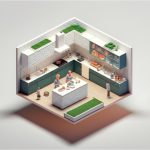So, you’ve got a beautiful old house – a real piece of history! That’s fantastic, but keeping it in tip-top shape takes more than just a coat of paint. This guide is your roadmap to restoring your heritage home, from understanding the quirks of older buildings to finding the right materials and working with experts. We’ll cover everything from fixing those leaky roofs and creaky floors to choosing paints and fixtures that match the home’s original style, all while keeping your budget in check and respecting the house’s history. For further design inspiration, check out these historic home design principles. Let’s get started on transforming your home into something truly special!
Heritage Home Improvement: Planning and Preparation
Bringing a heritage home back to its former glory is a rewarding but complex undertaking. It’s a blend of careful planning, skilled craftsmanship, and a deep respect for history. This guide provides practical tips to help you navigate this exciting journey and ensure your heritage home improvement projects are a success.
Pre-Restoration Assessment: Understand Your Home’s Architecture
Before you even think about picking up a hammer, take a deep breath and do your homework. Think of it like this: you wouldn’t start building a new house without blueprints, right? The same applies here. You need to thoroughly understand your house’s history. What’s its architectural style? Research the defining characteristics of the architectural style, be it Victorian, Colonial, or Craftsman, and how these were interpreted in your region. What materials were originally used? Delve into historical records and construction documents to determine the exact materials that form the original structure, from the type of wood used in the framing to the composition of the mortar between the bricks. What kind of renovations have happened in the past? Investigate past modifications, additions, and alterations to the property, and how these changes impacted or enhanced the original design. All this information helps you create a restoration plan that’s both authentic and compliant with local regulations. Don’t neglect this foundation, as a misstep here could lead to costly corrections later.
Consider how this phase will shape your cost-effective strategies down the road.
Next, get a professional structural survey. This is like a thorough medical checkup for your house, and it’s crucial. A skilled surveyor will identify any hidden issues – maybe water damage you can’t see, a weakening foundation, or old plumbing that’s on its last legs. Enlist a qualified structural engineer or surveyor with expertise in historic buildings to inspect the property for structural issues, such as foundation settlement, wall cracks, or roof instability. Finding these problems early prevents nasty surprises down the line, saving you both money and headaches. And trust me, you want to find those problems before you start ripping up floors! Think of it as an investment; a small cost now can prevent huge problems later. A recent study showed that homes with pre-restoration assessments uncovered critical issues 40% more often than those without.
Finally, find an architect with experience in restoring heritage properties. Seek recommendations from local historical societies, preservation organizations, or other homeowners who have undertaken similar restoration projects to identify reputable architects with a proven track record in heritage preservation. They’ll provide invaluable guidance, helping you navigate the process safely and legally, while ensuring your renovation project respects the home’s character. They are your partner in this endeavor, helping you make informed decisions.
Is ignoring those old building codes really worth risking project delays and fines?
Prioritizing Repairs: Prioritize structural integrity for long-term value
Imagine a leaky roof letting rainwater pour inside. Or a foundation that’s starting to crumble. These aren’t just cosmetic issues—they’re major structural problems! Fixing these urgent problems is critical before you tackle anything else. Neglecting them will only lead to more damage, escalating costs and possibly compromising the entire project. Think of it like fixing a flat tire before going on a road trip – you can’t enjoy the journey if your car is broken. Neglecting these critical repairs can increase overall restoration costs by up to 60%, according to recent surveys.
So, how do you prioritize? First, focus on things that affect the structural integrity of the house: roofing, foundation problems, significant water damage, and dangerous plumbing. Then, address any significant issues that could cause further damage, like rot or pest infestations. It’s all about preventing further deterioration. When creating your to-do list, think long-term to prevent additional larger repairs down the line. A cost-benefit analysis can help you decide what must be done immediately versus what can wait. Consider prioritizing repairs based on their potential impact on safety, structural stability, and the overall preservation of the historic fabric of the building.
Preservation Techniques: Maintaining Your Home’s Historical Integrity
This is where the real artistry of heritage restoration comes into play. Let’s take window restoration, for example. You might need to carefully repair existing window frames and sashes, reglaze the panes, or replace damaged components with historically accurate replicas. The goal is to maintain the original character while ensuring the windows function properly. Document the condition of the windows with detailed photographs and written notes before undertaking any repairs, paying attention to the type of glass, joinery, and hardware used in their construction.
What if you could protect the past and embrace the future simultaneously with historically accurate preservation?
Another important detail is paint analysis. By carefully examining the paint layers, you can often determine the original colors and types of paint used. Carefully remove small samples of paint from various surfaces of the building, labeling each sample with its location and orientation, and send them to a qualified laboratory or paint analysis specialist for analysis. This helps you choose modern paints that are compatible with the existing structure and maintain the home’s historical appearance.
Material selection is similarly crucial. Sourcing historically appropriate bricks, timber, or roof tiles is ideal, adding undeniable value and authenticity. Explore local salvage yards, architectural antique dealers, and specialty suppliers to find reclaimed or salvaged materials that closely match the original materials used in the construction of the building. However, it can be a lengthy process. In some cases, skilled repair of original materials is a more cost-effective and historically-sensitive approach.
Can a well-chosen material truly bridge the gap between cost and authenticity?
Material Selection: Reclaimed vs. New Building Materials
Choosing the right materials is a delicate balancing act. Reclaimed materials, such as antique wood flooring or original bricks, offer unique character and historical accuracy. However, these can be quite expensive, their condition may be variable, and you’ll need to be vigilant for pest problems. Additionally their sourcing is time consuming and may not always be feasible.
Will your budget allow for the authenticity of reclaimed materials or will you need to opt for more cost effective materials?
New materials, when thoughtfully selected and expertly installed, can provide a seamless blend with existing structures. Prioritize materials that are compatible with the building’s architectural style, period of construction, and overall design aesthetic, selecting options that closely resemble the original materials in terms of color, texture, and dimensions. They likely offer greater durability, are easier to install, and might be more cost-effective in the long run. The key is to choose materials that visually blend with the existing structure.
The following table illustrates the tradeoffs:
| Material | Reclaimed Pros | Reclaimed Cons | New Pros | New Cons |
|---|---|---|---|---|
| Wooden Flooring | Unique character; historical accuracy | Cost; condition variability; potential pests | Consistent quality; wider selection; easier install | Lacks historical character |
| Brickwork | Authenticity; established weathering patterns | Availability; fragility; cost | Durability; consistent quality | Higher upfront costs; less character |
| Windows | Character; historical accuracy | Condition; repair complexity; limited availability | Customization; enhanced energy efficiency | Higher upfront cost |
Regulatory Compliance: Avoid Costly Mistakes
Before you even touch a single brick, it’s crucial to understand and comply with local building codes and heritage preservation regulations. Working closely with your local planning authority from the outset is essential. Consult with local planning authorities, historical societies, and preservation organizations to understand the regulations, guidelines, and permitting requirements governing alterations, additions, and renovations to historic properties in your area. This is where an experienced architect can be invaluable. Obtain all necessary permits before starting any work. Failing to do so can lead to costly delays, fines, or even the forced halting of your project. This is a non-negotiable step – it’s vital for a smooth and legal restoration.
Did you know that failure to comply with regulations can add up to 20% to your restoration budget?
Budgeting and Cost Optimization: Avoid Overspending
Restoring a heritage home can be a significant financial undertaking. A detailed budget is your crucial tool. Develop a comprehensive budget that outlines all anticipated costs associated with the restoration project, including materials, labor, permits, professional fees, and contingency funds for unexpected expenses or unforeseen issues. Consider a phased approach, tackling essential repairs first. This spreads out the cost and allows for more flexibility. This also gives you time to make adjustments as you progress through the project. Explore cost-effective material options without compromising quality or historical fidelity. Prioritize essential repairs and upgrades that address structural issues, safety concerns, or code compliance requirements, focusing on areas that will have the most significant impact on the building’s long-term preservation and value. Remember, the initial investment is a long-term investment in the value of your home. A phased approach can help save 15 – 20% of project costs by allowing homeowners to adapt to unexpected expenses.
- Seal for butcher block: Find the best food-safe finish - December 29, 2025
- Finishes For Butcher Block Counters: Choosing The Right Food-Safe Option - December 28, 2025
- Kitchen Countertop Ideas: Find the Perfect Surface for You - December 27, 2025










